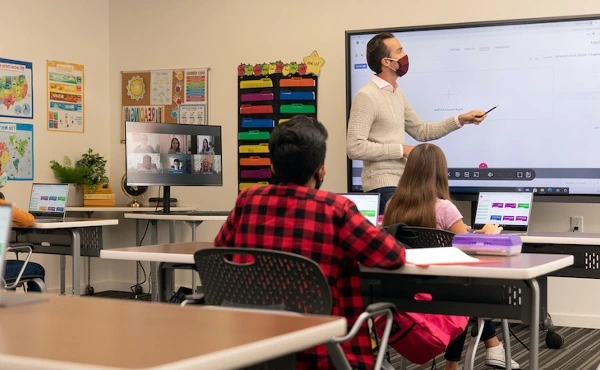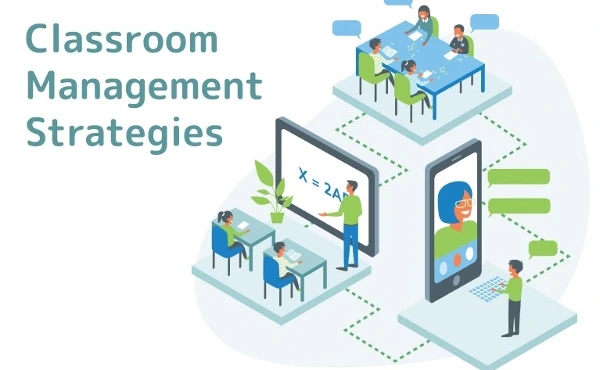
Thanks to the incorporation of smart technology, schools are changing to become more engaging and effective in today's tech-driven society. This evolution calls for changes in classroom management strategies in addition to instructional strategies. Successful teaching has always required a well-organized classroom management plan, but in order to fully utilize contemporary resources, educators now also need to concentrate on creating a clever classroom management approach that integrates with a school management system for seamless operation.
We will discuss the definition of smart classroom management, the advantages of incorporating technology into classroom management, and how to develop a successful classroom management strategy that makes use of smart tools in this blog. After reading this tutorial, you'll have the knowledge necessary to update your strategy and maintain order in your classroom organized, engaged, and efficient.
How does Smart Classroom Management work?
The term smart classroom management describes the application of digital tools and technology to improve the learning environment and simplify classroom management. It goes beyond simply utilizing technology in the classroom—rather, it involves making sure that it actively supports improved engagement, discipline, and overall functionality.
Teachers assist learning in a smart classroom by using interactive resources like tablets, smartboards, and learning management systems (LMS). More significantly, though, these capabilities support individualized learning, progress monitoring for students, and order maintenance. Smart classroom technology gives educators and students the ability to actively participate in controlling the learning process, in contrast to traditional management approaches where the instructor serves as the only source of direction and order.
Why a Classroom Management Plan Is Necessary
Let's first discuss the significance of having a strong classroom management strategy before getting into the intricacies of smart classroom management. A classroom's policies, protocols, and expected behaviors are described in a management plan. It offers a structure for consistency, assisting educators in creating routines, encouraging good behavior, and averting disruptions.
Even in hectic and varied environments, learning can proceed without hiccups when a classroom management strategy is implemented successfully. Teachers can accomplish these goals more quickly by developing a plan that includes smart tools, as technology becomes an increasingly important part of education.
Key Benefits of Smart Classroom Management
1. Enhanced Interaction and Engagement
Increased student involvement is one of the main advantages of smart classroom management. Students are more inclined to participate when there are interactive whiteboards, tests, and learning applications available. With the use of these resources, students can participate in the learning process as opposed to just being passive recipients of information.
Students can take quizzes, work together to solve problems, and have real-time discussions while utilizing a smartboard, for instance. Students remain attentive when they can engage directly with the course material, and teachers should take use of this opportunity to reinforce classroom procedures and norms.
2. Personalized Learning
Teachers can better meet the needs of each individual student with the help of smart technology. Adaptive learning platforms are among the tools that employ data analytics to track each student's progress and give teachers the insights they need to modify their lectures.
Having this degree of customization is essential to effective classroom management. A well-thought-out strategy will consider how each tool may help customize learning opportunities to fit various skill levels, passions, and learning preferences. Pupils are more likely to remain attentive and adhere to classroom regulations when they believe that their education is tailored specifically to them.
3. Monitoring and assessment made easier
Monitoring student performance and behavior is one of the most difficult parts of running a classroom. This is made easier by intelligent systems that give teachers access to real-time data on student activities, enabling them to keep an eye on engagement, attendance, and academic success in addition to student progress.
For instance, behavior tracking applications and learning management systems (LMS) enable teachers to monitor student activities all day long. With the use of this data, educators may promptly spot trends and step in to support a student in need, minimizing disruptions and maintaining the flow of learning.
4. Reduced Teacher Workload
The decrease in teacher burden that comes with utilizing smart tools for classroom management is another fantastic advantage. Teachers can concentrate more on teaching and developing relationships with their students by automating chores like making attendance records, assigning grades, or even keeping an eye on student conduct.
Using smart tools in a classroom management strategy can help automate administrative chores that are repetitive. For example, digital attendance systems may automatically track who is present or absent without interfering with the lesson plan, while grading apps enable teachers to provide immediate feedback to their students.
How to Draft an Informed Classroom Management Strategy

Carefully integrating technology with conventional management practices is necessary to create an efficient smart classroom management plan. Here's a step-by-step tutorial to get you going:
1. Establish definite objectives for the classroom
Establishing specific objectives for your use of smart technology in the classroom should be the first step in creating your plan. Are you looking to raise student involvement? Boost individualized education? Minimize disturbances? Determining your objectives can assist you in selecting the appropriate resources for your smart classroom.
2. Select the Appropriate Smart Instruments
Every technology is not made equally. Choosing resources that support your goals is essential for smart classroom management success. Behavioral tracking apps, learning management systems (LMS), and interactive whiteboards are a few common choices.
For instance, ClassDojo can assist with tracking student conduct in an engaging, interactive manner, while Google Classroom can streamline communication, assignment distribution, and grading.
3. Create policies and guidelines
It is crucial to have explicit policies and procedures, even in a smart classroom. Include technology in these recommendations. You may establish guidelines regarding, for instance, when and how students can access specific digital tools or how they should use their devices during class.
Incorporate processes for resolving technological issues into your classroom management plan so that students know what to do in the event that a gadget breaks or they experience issues with an app.
4. Track Development and Make Modifications
A clever classroom management system that works well is adaptable. Evaluate your plan's and your tools' efficacy on a regular basis. To keep an eye on classroom dynamics and student achievement, use the data produced by smart tools. In light of this information, modify your strategy as necessary to continue improving classroom management and student outcomes.
Difficulties in Putting Smart Classroom Management Into Practice
Even if there are many advantages to smart classroom management, it's crucial to be mindful of any potential drawbacks:
Technical Difficulties:
Technical difficulties, such software bugs or Wi-Fi connectivity problems, might cause lectures to be interrupted. It's critical to have backup plans in place.
Student Distractions:
Because they have access to so much technology, kids could get easily sidetracked. A well-designed plan can reduce this by establishing stringent rules around the use of devices.
Teacher Training:
In order to use smart gadgets effectively, teachers must have the appropriate training. To make sure that teachers are comfortable using these tools into their lessons, schools need to make investments in their professional development.
Conclusion
Your classroom management approach can be greatly improved by integrating smart technology into the classroom. A well-thought-out smart classroom management plan can help you establish a more individualized learning environment, engaged students, and reduced administrative duties.
Teachers who adopt smart classroom solutions will be better prepared to manage the opportunities and challenges of contemporary education as it continues to change. You can design a successful strategy that integrates technology with conventional classroom management techniques to establish a productive learning environment by following the instructions provided in this tutorial. Ready to explore various classroom management theories, check out our blog Understanding Classroom Management Theories: A Guide for Educators